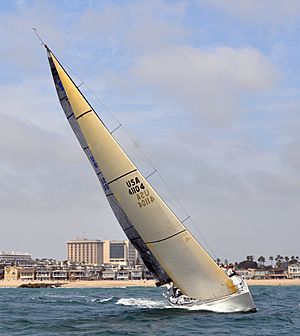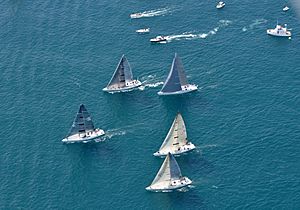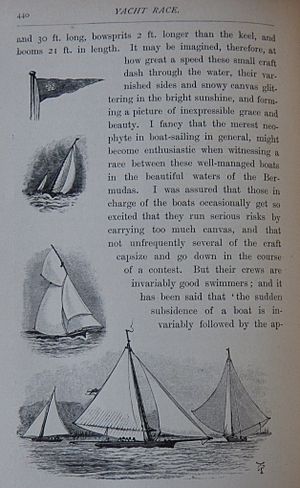Yacht racing facts for kids
Yacht racing is a fun and exciting sailing sport. It involves large sailing yachts and other big sailboats. This is different from dinghy racing, which uses smaller, open boats. In yacht racing, many yachts compete against each other. They race around a course marked by buoys or other fixed points. Sometimes, they race long distances across open water from one place to another. A competition can be a series of short races or a long race with several parts.
Contents
History of Yacht Racing
People have enjoyed boating for fun, also called yachting, for a very long time. An old poem from ancient Rome, called Catullus 4, even talks about a fast boat:
The yacht you see there, friends,
says that she's been
The fastest piece of timber ever seen;
She swears that once she could have overhauled
All rival boats, whether the challenge called
For racing under canvas or with oars.
The word "yacht" comes from old words meaning "to hunt, chase, or pursue." This shows that these boats were built for speed!
Formal boat racing likely began with sailboats in the Netherlands in the 1600s. Soon after, in England, people started building special "yachts" just for racing. The Royal Yacht Squadron, a famous sailing club, was started in 1815. In 1661, a writer named John Evelyn wrote about a race between two large royal sailing ships, Katherine and Anne. The race was from Greenwich to Gravesend and back, and the prize was £100. One of the ships was owned by King Charles II, who sometimes even steered it himself. The king lost that race!
In 1782, a type of sailing vessel called the Cumberland Fleet was painted racing up the River Thames. Spectators watched from a bridge. Just like today, sailors loved making their boats go fast and sail well, especially close to the wind.
In the 1800s, most yacht races started with boats lined up. They would tie their yachts to buoys with ropes. Sailors had to keep all their front sails on deck until the starting signal. But in 1875, the Yacht Racing Association was founded. They wrote new, standard rules for yacht racing, including the "Flying Start" that is still used today. In a flying start, boats cross the starting line at full speed after a signal.
One of the most famous yacht races, the America's Cup, first took place in 1851. It was a race between the New York Yacht Club and the Royal Yacht Squadron. The America's Cup races usually happen every three or four years. The club that holds the Cup is challenged by another club. The New York Yacht Club held the Cup for a very long time, until 1983!
As of 2017, a yacht called Partridge 1885, based in La Ciotat, is known as the world's oldest classic racing yacht that is still fully working.
Rules and Fair Play

As yacht racing became more popular and boats were designed in many different ways, it became important to have rules. Longer yachts are naturally faster than shorter ones. To make races fair, a simple system of "time allowance" was introduced in the 1820s. This meant bigger yachts were given a handicap, like a time penalty. But some owners of the biggest boats didn't like this. They thought the first boat to cross the finish line should win, just like in running or horse races. Because of this, two main ways to make racing fair were developed: "ratings" and "one-design" races.
Ratings systems use a special formula to look at a yacht's design. They consider things like its length, sail area, how much water it pushes aside (its displacement), and the shape of its hull. For many years, from the 1920s to the 1970s, the Cruising Club of America had a formula that helped design most racing and cruising boats. Later, a very complex rule called the International Offshore Rule (IOR) made boats less safe and even slower. So, a simpler system called Performance Handicap Racing Fleet (PHRF) was adopted.
The PHRF system uses a boat's proven performance, especially its theoretical speed, to let different types of yachts race together fairly. This system is popular for club races where friends and families compete, not professional crews. Most popular family cruising sailboats have a rating with a local PHRF group.
Today, the most common handicap rating systems are the Offshore Racing Congress (ORC), Offshore Racing Rule (ORR), International Rating Certificate (IRC), and the Performance Handicap Racing Fleet (PHRF). Some countries also have their own handicap systems. For example, the Irish E.C.H.O. system measures performance based on past race results, not just the boat's size or design.
One-design racing was invented in 1886 by Thomas (Ben) Middleton in Ireland. He was worried that winning a race depended more on having an expensive new yacht than on the sailor's skill. In one-design racing, all the boats are built to the exact same design. They have the same sail area, the same setup, and the same number of crew. This means that the skill of the crew and their race strategy are what truly decide who wins, not the boat's type, age, or even the weather. Popular one-design racing boats include The Water Wag, Laser, the J/22 and J/24, the Etchells, and the Star.
Most modern yacht races follow the Racing Rules of Sailing. These rules were first created in 1928. Even though they can seem complex, their main goal is to make sure races are fair and safe for everyone. The rules are reviewed and updated every four years by an organization called World Sailing.
Famous Yacht Races
Today's major yacht races can be grouped into different types: offshore, ocean, around-the-world, and inshore races. They all follow the same basic rules but use different ways to handicap boats.
Offshore Races
- Vic-Maui Yacht Race: This race starts in Victoria, Canada, and ends in Lahaina, Hawaii. It's about 2,308 nautical miles (4,274 km) long and happens every two years.
- Transpacific Yacht Race: Known as Transpac, this race starts near Los Angeles and finishes near Diamond Head Lighthouse in Honolulu. It's about 2,225 nautical miles long and is one of the most important offshore races.
- Fastnet: Started in 1924, this race covers about 600 miles. It begins at Cowes on the Isle of Wight, goes around Fastnet Rock off Ireland, and finishes at Plymouth.
- Tour De France A La Voile: This race started in 1978 and is like the cycling event, but on water! It takes place along France's coasts and covers over 1,000 miles.
- Sydney to Hobart Yacht Race: This Australian race began in 1945. It runs from Sydney to Hobart, Tasmania, covering over 682 nautical miles.
- Melbourne to Hobart Westcoaster: This 440 nautical mile race crosses Bass Strait, goes down the rugged West Coast of Tasmania, and finishes in Hobart.
- Newport to Bermuda: Started in 1906, this race goes from Newport, Rhode Island to Bermuda, which is about 640 miles off Cape Hatteras.
- Chicago Yacht Club Race to Mackinac: Founded in 1898, this race goes from Chicago, Illinois, to Mackinac Island in Michigan. It covers over 300 miles of freshwater racing.
- Marblehead to Halifax race: Started in 1905, this race runs from Marblehead, Massachusetts, to Halifax, Nova Scotia, covering over 360 miles.
- Coastal Classic: Since 1982, this has been New Zealand’s main fleet race. It's shorter than most offshore races, about 125 miles, running north from Auckland to Russell.
- Regata del Sol al Sol: Established in 1968, this race goes from St. Petersburg, Florida, to Isla Mujeres, Mexico. It's a 500 nautical mile race in the Caribbean Sea.
Ocean Classics
- Ostar: First held in 1960, this is a single-handed race (one person per boat) across the North Atlantic. Sailors race against the wind and current. It happens every four years.
- Route Du Rhum: Started in 1978, this race happens every four years in November. It's mainly a single-handed race, starting in France and finishing in Guadeloupe in the Caribbean. It covers about 3,700 miles.
- Mini Transat: Started in 1977, this is another single-handed race held every two years. It crosses the Atlantic in two parts: first from France to the Canary Islands, then to Guadeloupe Island.
- South Atlantic: Originally called the Cape to Rio race, it began in 1971. It runs from Cape Town, South Africa, to Rio de Janeiro, covering 3,600 miles.
- Round Ireland Yacht Race: This race is about 704 miles long and happens every two years. It goes around all of Ireland's offshore islands (except Rockall) and starts and finishes in Wicklow.
Around-the-World Races
- The Ocean Race: This race, also known as the Volvo Ocean Race, started in 1973/74. It's one of the toughest yacht races, mostly sailed by professional crews. It now has nine legs and covers many miles around the world.
- Velux 5 Oceans Race: This single-handed race around the world started in 1982. It used to have four legs but now has three.
- Global Challenge: Started in 1992/93 by Sir Chay Blythe, this race is unique because participants sail against the strong winds and currents around the world. The race uses special one-design boats, and the crews are made up of new sailors who pay to join.
- Vendée Globe: Known as the Everest of the Seas because it's so difficult, this race started in 1989. It's a single-handed, non-stop race around the world, with no outside help allowed.
- Jules Verne Trophy: Established in 1993, this race is a challenge against time, not other boats. Teams can start anytime, use any boat design, and have any number of crew. The only rules are to start and finish at Ile d’Ouessant and complete the journey in under 80 days.
- Clipper Round the World Yacht Race: Started by Sir Robin Knox-Johnston, this race began in 1996. It uses a fleet of 12 identical one-design boats. Each boat has a professional skipper and paying amateur sailors. It's the longest yacht race, taking 11 months to sail around the world with many stops.
- Barcelona World Race: This is a double-handed (two-person crew) non-stop race around the world. It uses IMOCA Open 60 yachts.
Inshore Races
- The Admirals Cup: Created in 1957, this competition happened every two years. It was a race between countries, where each country sent one team with three boats of a chosen design. This event no longer takes place.
- The America's Cup: Started in 1851, this is the oldest and most famous yacht racing event. The rules about boat design have often been debated. The English, who challenged for the Cup for 132 years, once joked, "England rules the waves, but America waives the rules."
- The Heather Cup: This race is held every year as part of the Auckland Anniversary Regatta, which started in 1840.
See also
 In Spanish: Vela de Crucero para niños
In Spanish: Vela de Crucero para niños





